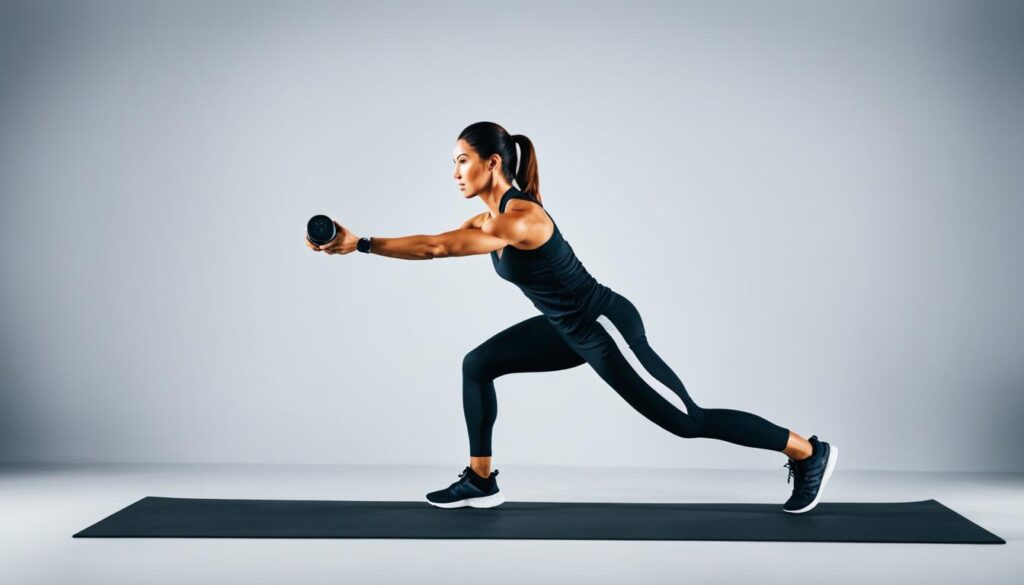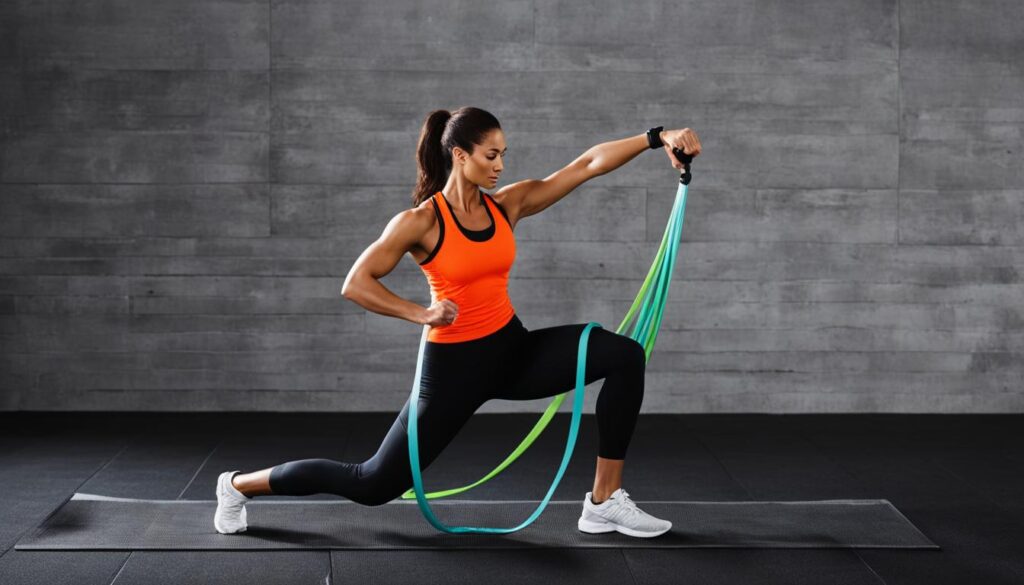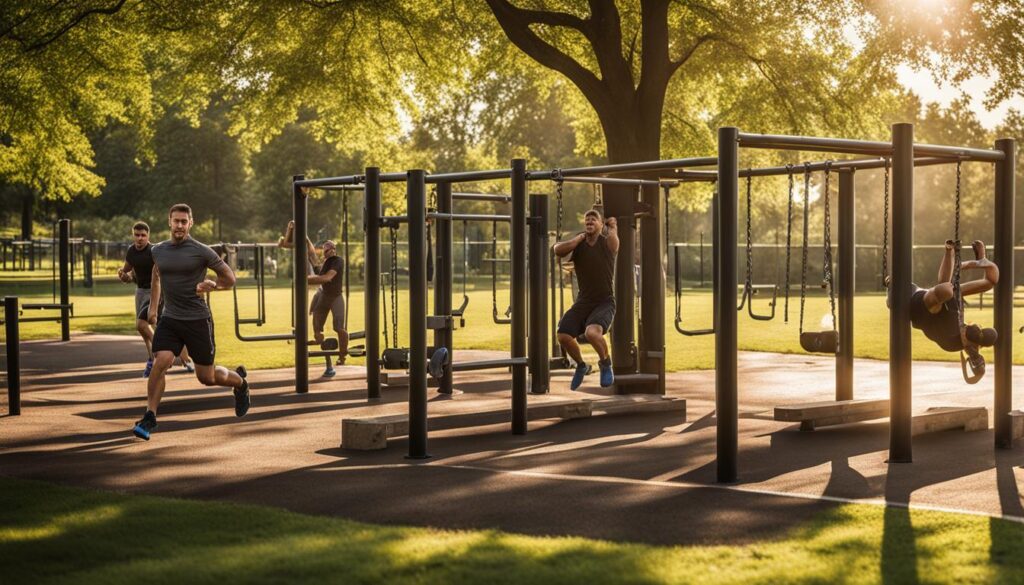Are you a busy parent or high-powered executive struggling to find time for workouts? If so, efficient fat-burning circuit training is the solution for you. These time-efficient workouts maximize calorie burn in minimal time and provide numerous benefits for effective fat loss. With quick workout routines, you can achieve maximum calorie burn and enhance your fitness despite your busy lifestyle. Circuit training also offers metabolic conditioning and a variety of circuit training circuits to keep your workouts interesting and effective.
Key Takeaways:
- Efficient fat-burning circuit training is ideal for busy individuals looking to maximize their workout results.
- Circuit training offers time-efficient workouts that allow for effective fat loss in minimal time.
- Quick workout routines enable busy people to achieve maximum calorie burn and enhance their fitness.
- Metabolic conditioning is a key benefit of circuit training, improving the body’s ability to burn calories at rest.
- Circuit training circuits add variety and keep workouts interesting and effective.
The Benefits of Circuit Training
Circuit training is a highly effective form of exercise that offers a range of benefits. One of the main advantages of circuit training is its ability to promote fat burning. By combining resistance exercises and high-intensity aerobic exercises, circuit training can effectively burn fat and help you achieve your weight loss goals.
Circuit training is also known for its time efficiency. With today’s busy lifestyles, finding the time to work out can be a challenge. However, circuit training allows you to optimize your workout in a short amount of time. By performing a series of exercises in quick succession with minimal rest, you can get a full-body workout in as little as 20-30 minutes.
In addition to fat burning and time efficiency, circuit training also provides metabolic conditioning. This means that it improves your body’s ability to burn calories not just during the workout, but also at rest. By engaging different muscle groups and challenging your cardiovascular system, circuit training boosts your overall metabolic rate and helps you achieve effective fat loss.
Overall, circuit training is an effective and efficient way to achieve your fitness goals. It combines fat burning exercises with time-efficient workouts and metabolic conditioning, making it a powerful tool for effective fat loss and overall health improvement.
“Circuit training is a dynamic and versatile form of exercise that targets multiple aspects of fitness, including cardiovascular endurance, muscular strength, and fat loss.” – Fitness expert
High-Intensity Interval Training (HIIT)

High-intensity interval training, or HIIT, is a form of exercise that alternates between intense work periods and less intense recovery periods. This type of training is highly effective for burning calories and maximizing fat loss. By pushing your body to its limits during the work periods, you can achieve a higher calorie burn in less time compared to steady-state cardio exercises.
HIIT can be tailored to your fitness level and can include a variety of exercises such as sprints, burpees, and spin bikes. These intense bursts of activity followed by short recovery periods challenge your cardiovascular system and boost your metabolism, resulting in accelerated fat burning and improved fitness.
The benefits of HIIT include:
- Time-efficiency: HIIT workouts are typically shorter in duration but provide the same or even greater cardiovascular and metabolic benefits compared to longer, steady-state workouts.
- Maximum calorie burn: The intense nature of HIIT workouts allows you to burn a significant amount of calories during and even after your workout. This is known as the “afterburn effect” or excess post-exercise oxygen consumption (EPOC).
- Versatility: HIIT can be adapted to various exercises and workout formats, making it suitable for individuals of different fitness levels and preferences. You can customize your HIIT routine based on your goals and the equipment available to you.
Ready to give HIIT a try? Check out the table below for a sample HIIT workout:
| Exercise | Duration | Intensity | Recovery |
|---|---|---|---|
| Sprints | 30 seconds | Max effort | 30 seconds |
| Burpees | 30 seconds | High intensity | 30 seconds |
| Mountain climbers | 30 seconds | Medium intensity | 30 seconds |
| Jump squats | 30 seconds | High intensity | 30 seconds |
| Rest | 1 minute | N/A | N/A |
Remember to listen to your body and start with a workout that matches your fitness level. Gradually increase the intensity and duration as you build up your stamina and strength. It’s also important to warm up before starting your HIIT workout and cool down afterward to prevent injuries and promote recovery.
Circuit Training Workouts
Circuit training is a highly effective form of exercise that combines both resistance exercises and high-intensity aerobic exercises. It involves moving through a series of exercises without resting in between, making it a time-efficient workout option for busy individuals. Circuit training circuits are designed to keep your workouts challenging and diverse, targeting multiple muscle groups and maximizing calorie burn.
The Benefits of Circuit Training Circuits
“Circuit training offers a range of benefits, including effective fat burning and metabolic conditioning.”
One of the major benefits of circuit training circuits is their ability to promote fat burning. By incorporating a combination of resistance exercises and high-intensity aerobic exercises, circuit training circuits create an optimal environment for calorie burn and effective fat loss. Additionally, these workouts are time-efficient, allowing you to fit in a complete workout in a shorter amount of time compared to traditional workouts.
Circuit training circuits also provide metabolic conditioning, which improves your body’s ability to burn calories even at rest. This means that even after your workout is over, your body continues to burn calories, helping you achieve your fitness goals more efficiently.
Examples of Circuit Training Circuits
Here are some examples of circuit training circuits that you can incorporate into your routine:
- 1. Jump Squats
- 2. Push-ups
- 3. Walking Lunges
- 4. Dumbbell Rows
- 5. Plank
- 6. Jumping Jacks
These exercises target different muscle groups and can be performed with minimal equipment or even just body weight. By completing multiple circuits with short rest periods in between, you can ensure maximum calorie burn and improve your metabolic conditioning.
Summary
Circuit training workouts are an efficient way to burn fat, improve your fitness, and save time. By incorporating a variety of exercises into your circuit training circuits, you can challenge your body and achieve your fitness goals. Remember to perform the circuits with minimal rest periods to maintain the intensity and maximize calorie burn. Whether you’re a beginner or an advanced exerciser, circuit training workouts offer a time-efficient and effective way to stay in shape.
Tabata Workouts

Tabata workouts are a highly effective form of high-intensity interval training (HIIT) that can help you burn fat and achieve your fitness goals in a short amount of time. Developed by Dr. Izumi Tabata, these workouts consist of brief, intense bursts of exercise followed by short rest periods. Each Tabata workout lasts only four minutes but delivers maximum results.
During a Tabata workout, you perform an exercise at high intensity for 20 seconds, followed by 10 seconds of rest. This pattern is repeated for eight rounds, totaling four minutes. The intense nature of Tabata workouts pushes your body to its limits, causing your heart rate to skyrocket and your muscles to work harder, resulting in increased calorie burn and fat loss.
Tabata workouts are versatile and can incorporate a variety of fat burning exercises, such as squats, pushups, rowing, and crunches. The key is to choose exercises that engage multiple muscle groups and allow you to work at a high intensity. By alternating between different exercises, you can keep the workout challenging and stimulating.
These quick workout routines are ideal for individuals with busy schedules who want to make the most of their limited time. With just four minutes of intense exercise, Tabata workouts offer a time-efficient solution to burn fat and improve both muscular and cardiovascular fitness.
| Exercise | Duration |
|---|---|
| Squats | 20 seconds |
| Rest | 10 seconds |
| Pushups | 20 seconds |
| Rest | 10 seconds |
| Rowing | 20 seconds |
| Rest | 10 seconds |
| Crunches | 20 seconds |
| Rest | 10 seconds |
| Squats | 20 seconds |
| Rest | 10 seconds |
| Pushups | 20 seconds |
| Rest | 10 seconds |
| Rowing | 20 seconds |
| Rest | 10 seconds |
| Crunches | 20 seconds |
Remember to push yourself to the maximum during each 20-second interval and maintain proper form throughout the workout. As with any exercise program, it’s important to consult with a healthcare professional before starting Tabata workouts, especially if you have any underlying health conditions or injuries.
The Importance of Warm-Up and Stretching

Before starting any circuit training workout, it is important to warm up and stretch properly. This helps prepare your muscles and joints for the upcoming exercises and reduces the risk of injury.
A warm-up can include activities such as jogging in place, air punches and kicks, or jumping jacks. It raises your body temperature, increases blood flow, and loosens your muscles, making them more pliable and ready for action.
Along with a warm-up, stretching exercises can help improve flexibility and prevent muscle strains. It is recommended to perform dynamic stretches that mimic the movements you will be doing during the workout. Dynamic stretching not only improves flexibility but can also enhance your performance during the circuit training session.
Taking the time to warm up and stretch before your circuit training session ensures a safe and effective workout. It primes your body for the demands of the exercises, increases your range of motion, and minimizes the risk of injuries such as muscle pulls or strains.
Remember, a proper warm-up and stretching routine is an essential part of any workout program. Don’t skip it!
Benefits of Warm-Up and Stretching:
- Prepares muscles and joints for exercise
- Reduces the risk of injury
- Increases blood flow and body temperature
- Improves flexibility
- Enhances performance during the workout
Tips for Effective Warm-Up and Stretching:
- Start with 5-10 minutes of light aerobic activity such as jogging or jumping jacks.
- Perform dynamic stretches that target the major muscle groups you will be using during the workout.
- Move through a full range of motion during the stretches, but avoid bouncing or jerking movements.
- Hold each stretch for 15-30 seconds and repeat 2-3 times.
- Focus on your breathing and relax into the stretches.
Can I Incorporate Circuit Training Into My Equipment-Free Fat-Burning Workout?
Yes, you can easily incorporate circuit training into your equipment-free effective fat-burning workouts. Circuit training involves a series of high-intensity exercises with short rest periods, making it ideal for burning calories and improving cardiovascular fitness without the need for equipment.
Circuit Training at the Playground

The playground offers a unique and dynamic setting for circuit training workouts, making it an ideal choice for those who prefer outdoor exercises. By taking advantage of the equipment available at the playground, you can create a challenging and effective workout routine that combines bodyweight exercises with the surrounding structures. This allows you to incorporate resistance training and increase the intensity of your circuit training sessions.
Some examples of bodyweight exercises that can be performed at the playground include:
- Step-ups on the stairs or platforms
- Push-ups using a sturdy bench or playground structure
- Swing rows by gripping the swing chains and pulling yourself towards the swing-set
- Lunges while utilizing the open space on the playground
- Reverse crunches by hanging from monkey bars and pulling your knees up towards your chest
These bodyweight exercises target major muscle groups and provide a full-body workout. By incorporating them into your circuit training routine, you can build strength, improve endurance, and enhance your overall fitness.
Furthermore, circuit training at the playground offers a fun and versatile workout option for individuals of all ages. Whether you’re a parent looking to exercise with your kids or simply enjoy the outdoor environment, the playground provides a stimulating and engaging atmosphere to reach your fitness goals.
Incorporating Kettlebells in Circuit Training

Kettlebells are a versatile tool that can greatly enhance the effectiveness of your circuit training workouts. By incorporating kettlebell exercises into your routine, you can target multiple muscle groups and maximize calorie burn, leading to more efficient fat burning and improved overall fitness.
Here are some key kettlebell exercises that can be integrated into your circuit training sessions:
- Kettlebell swings: This exercise targets your glutes, hamstrings, and core while providing a cardio element to your workout. Stand with your feet shoulder-width apart, holding the kettlebell with both hands. Bend your knees slightly, hinge at the hips, and swing the kettlebell in a fluid motion between your legs and up to chest height.
- Goblet squats: This exercise targets your quads, glutes, and core. Hold the kettlebell close to your chest, with your elbows pointing down. Lower yourself into a squat position, making sure to keep your knees aligned with your toes. Push through your heels to return to the starting position.
- Overhead presses: This exercise targets your shoulders, triceps, and core. Start with the kettlebell at shoulder height, with your palm facing forward. Press the kettlebell overhead while keeping your core engaged and your back straight. Lower the kettlebell back to shoulder height and repeat.
- Bent over rows: This exercise targets your back, biceps, and core. Stand with your feet shoulder-width apart, holding the kettlebell with one hand. Hinge at the hips, keeping your back straight, and let the kettlebell hang in front of you. Pull the kettlebell towards your chest, squeezing your shoulder blades together. Lower the kettlebell back down and repeat on the other side.
- Front rack reverse lunges: This exercise targets your quads, glutes, and core. Start by holding the kettlebell in front of your chest, with your elbows pointing down. Step back into a lunge position, keeping your front knee aligned with your ankle. Push through your front heel to return to the starting position and repeat on the other side.
- Halos: This exercise targets your shoulders, core, and upper back. Hold the kettlebell by the horns, with your elbows bent at a 90-degree angle. Circle the kettlebell around your head in one direction, keeping your core engaged and your back straight. Repeat in the opposite direction.
By incorporating these kettlebell exercises into your circuit training routine, you can add variety and challenge to your workouts, leading to greater fat burning and improved strength. Remember to start with an appropriate weight for your fitness level and focus on maintaining proper form throughout each exercise.
| Exercise | Muscle Groups Targeted | Description |
|---|---|---|
| Kettlebell swings | Glutes, Hamstrings, Core | A dynamic exercise that combines cardio and strength training. Start with a kettlebell between your legs and swing it up to chest height, using the momentum generated by your hips. |
| Goblet squats | Quads, Glutes, Core | Hold the kettlebell close to your chest and perform squats while maintaining proper form. This exercise strengthens your lower body and core. |
| Overhead presses | Shoulders, Triceps, Core | Hold the kettlebell at shoulder height and press it overhead, engaging your core for stability. This exercise targets your shoulder muscles and improves upper body strength. |
| Bent over rows | Back, Biceps, Core | Bend at the hips and maintain a flat back while performing rows with the kettlebell. This exercise targets your back muscles and improves upper body strength. |
| Front rack reverse lunges | Quads, Glutes, Core | Hold the kettlebell in front of your chest and step back into lunges, focusing on balance and proper form. This exercise works your lower body and core. |
| Halos | Shoulders, Core, Upper Back | Hold the kettlebell by the horns and circle it around your head in a controlled manner. This exercise targets your shoulder muscles and improves upper body mobility. |
Conclusion
In conclusion, efficient fat-burning circuit training offers a time-efficient and effective solution for busy individuals looking to achieve their fitness goals. By incorporating circuit training into your routine, you can experience a wide range of benefits. Whether you opt for high-intensity interval training (HIIT), circuit training circuits, Tabata workouts, or kettlebell workouts, each type of workout provides unique advantages and can be customized according to your fitness level.
Before diving into your circuit training session, it is crucial to prioritize a proper warm-up and stretching routine. This helps prepare your muscles and joints for the upcoming exercises and reduces the risk of injuries. Engaging in dynamic stretches that mimic the movements you will be performing during your workout can further enhance flexibility and prevent muscle strains.
By embracing circuit training, you can maximize calorie burn, improve metabolic conditioning, and achieve effective fat loss in minimal time. With its diverse and engaging workouts, circuit training keeps fitness routines interesting and avoids monotony. So, whether you’re a busy parent, high-powered executive, or anyone looking for a time-efficient fitness solution, circuit training is the answer to your fitness goals.




